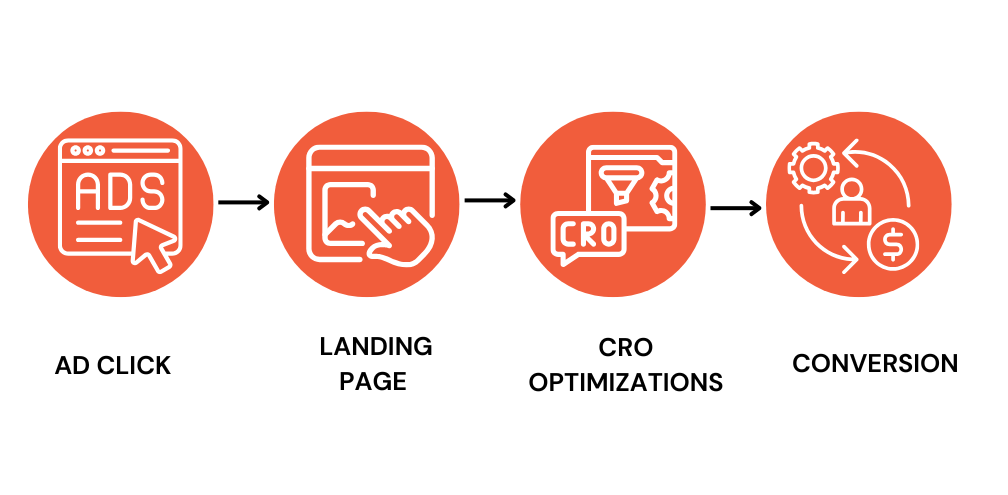TL:DR; Learn how Conversion Rate Optimization (CRO) boosts ROI on Google & Facebook Ads. Discover proven CRO strategies to lower CPA, improve UX, and turn clicks into loyal customers.
Why CRO Matters for Paid Advertising
If you’re investing in Google Ads, Facebook Ads, or any paid campaigns, driving traffic is only half the battle. The real question is: are those clicks turning into customers?
That’s where Conversion Rate Optimization (CRO) comes in. CRO ensures every visitor who lands on your site has the best possible chance of taking action—whether that’s booking a room, filling out a form, or making a purchase.
In this guide, we’ll break down:
What is CRO (Conversion Rate Optimization)?
Conversion Rate Optimization (CRO) is the process of improving your website or landing page to increase the percentage of visitors who complete a desired action.
Examples include:
- Clicking “Book Now”
- Submitting a lead form
- Signing up for a newsletter
- Making a purchase
Unlike SEO or paid ads, CRO focuses on maximizing the value of the traffic you already have. By using A/B testing tools, heatmaps, UX optimization, and conversion funnel analysis, CRO ensures every ad click has the highest chance of generating revenue.

Why CRO is Essential for Paid Advertising Success
1. Lower Cost Per Acquisition (CPA):
Ad costs keep rising across Google & Facebook. Without CRO, you’re paying for wasted clicks that don’t convert.
According to WordStream, the average Google Ads conversion rate is:
- 3.75% for Search Ads
- 0.77% for Display Ads
That means 96%+ of ad clicks don’t convert!
By applying website CRO best practices like simplified forms, stronger call to actions (CTAs), and faster landing page optimization, you can reduce CPA (cost per acquisition) and make every ad dollar count.
For a deeper dive into this topic, check out: Why Most Businesses Struggle to Convert Leads.
2. Higher ROI from Paid Ads
Running ads without CRO is like pouring water into a leaky bucket.
CRO patches those leaks, allowing you to:
- Generate more conversions from the same ad spend
- Improve ad ROI across both Google Ads & Facebook Ads
According to Google, a 1-second site speed improvement can boost mobile conversions by up to 27%—a game-changer when most ad traffic today comes from mobile devices.
Read more about the crucial role of website speed in our blog here.
3. Better User Experience = More Conversions
CRO is not about hacks—it’s about creating seamless user experiences (UX).
Examples of UX optimization include:
- Landing page headlines matching ad copy
- Clear site navigation
- Mobile-first design
A positive UX doesn’t just increase conversions. It also builds long-term trust and brand loyalty, meaning repeat customers and stronger lifetime value.
4. Data-Driven Growth with CRO Metrics
Every CRO test provides data that powers smarter business decisions.
- A/B testing tools reveal which CTAs, layouts, and headlines convert best
- Heatmaps (e.g., Hotjar) show where users click or drop off in the conversion funnel
- CRO KPI measurement with GA4 or HubSpot helps you refine campaigns
Instead of guessing, CRO makes every ad campaign smarter, more profitable, and scalable. Pairing CRO insights with evolving SEO strategies is key — explore SEO Trends You Can’t Miss in 2025
Best CRO Strategies to Boost Ad ROI
Here are proven conversion rate optimization strategies to maximize your Google Ads & Facebook Ads ROI:
-
Align Ad Copy with Landing Pages
Consistency builds trust. Ensure your landing page mirrors the promise made in your ads.
For example, if your ad promotes “20% Off Hotel Bookings,” your landing page should clearly highlight that same offer—no surprises, no confusion.
Less is more. The fewer fields your form has, the more likely visitors are to complete it. Focus only on essential information to reduce friction and increase conversions.
-
Use Strong Call-to-Actions (CTAs)
Move beyond generic “Submit” buttons. Action-oriented CTAs like “Book Your Stay Now” or “Claim Your Free Quote” guide visitors to take immediate action.
A slow-loading page can kill conversions. Test your site’s performance, especially on mobile, and make improvements to ensure visitors don’t abandon before the page even loads.
Showcase testimonials, reviews, and case studies to build credibility. Seeing that others have had positive experiences reassures visitors and encourages them to take action.
CRO Tools & Analytics You Should Use
To implement website CRO best practices, leverage tools that track performance across the conversion funnel:
- Google Optimize → A/B testing headlines, layouts, CTAs
- Hotjar / Crazy Egg → Heatmaps & session recordings
- HubSpot → Conversion tracking & marketing automation
- Google Analytics 4 (GA4) Funnels → Monitor CRO metrics & KPIs across customer journeys
💡 Example: Hotels can test booking form length, eCommerce stores can test free shipping banners, and B2B SaaS can test demo-request CTAs.
Next Steps: Turn Ad Clicks into Customers
If you’re running paid ads, Conversion Rate Optimization (CRO) isn’t optional—it’s essential. Without CRO, you risk losing valuable traffic and overspending on clicks that never convert.
By focusing on data-driven improvements, user experience, and continuous testing, you’ll not only lower costs but also maximize ROI and build lasting customer relationships.
Not sure where to start? Book a Free CRO Audit Today and see how our team can help you double your ROI with CRO best practices.
Frequently Asked Questions About CRO for Ad